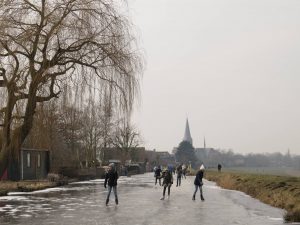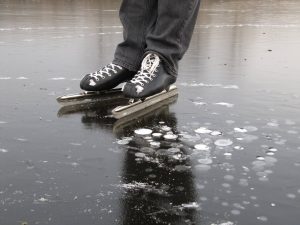Global warming reduces the chance of long lasting cold periods, the Dutch national weather service KNMI says on its website. Weeks of wintertime in the Netherlands have cut down to days, if not hours. Over the past 100 years, the average temperature of the coldest five consecutive days of a year has risen by about +2 degrees! Cold weeks like the one we experienced last week in February, occurred in 1900 twice as much as today. And so, without an agile mindset you easily miss the chance to enjoy wintertime.
Siberian bear
Seldom did freezing weather in the Netherlands start so late in the season. Friday February 23rd the meteorological office forecast Siberian cold air to be blown over the Netherlands. It would almost certainly result in an opportunity to skate on canals and other waterways in less than a week time. Daytime temperatures dropped to -5 and -10 centigrade, nighttime temperatures five degrees lower. The windchill by the strong wind from the east made it feel bitterly cold.
Their forecast was right. Within one week time hundreds of thousands Dutchmen skated on the waterways and lakes, even on the canals in the city centre of Amsterdam and Delft. Just on two days, Friday and Saturday. But on Sunday the thermometer indicated a spring temperature of +11 degrees centigrade, and Monday at sunrise I heard the song of a blackbird in my garden… Recent winters have shortened from weeks to days. There is little time to contemplate on whether you want to take a day off and skate: you have to be agile and immediately rearrange your agenda to create space for some hours of skating fun. There is no time to think twice!

One of the main canals in my village Saturday afternoon March 3, 2018 (private photo)
Skating is in the DNA of the Dutch
For foreigners it is difficult to imagine what influence freezing weather has on many Dutch citizens. It must be deep in our DNA. You may know the historic paintings of the 17th and 18th century that show skaters on frozen waterways on a sunny winter’s day, with snow covered cottages and windmills on the riverbanks, or skaters in winter landscapes with a stand on ice that sells hot chocolate milk, drinks and cakes (“Koek and Zopie”).
Little has changed. Also in today’s hectic world, freezing weather in the Netherlands stimulates fraternity and friendship that emanates from spontaneous initiatives by citizens. In my village all of a sudden villagers organised a local championship of “Curling 0.0”, using biscuit tins filled with gravel as the curling stones, while the local supermarket sponsored the Koek and Zopie stand, and the fire brigade arranged the floodlights on the ditch in the village centre. Out-and-out village entertainment anno 2018!
Good sense
Some things did change though. Where I learnt from my parents to assess the quality and thickness of the ice layer on the basis of the weather and the local conditions such as flows in the water, at present many people seem to have a blind trust in simulation models that predict the ice thickness growth in the waterways, on the basis of air temperature and wind speed and probably a couple of other parameters. But these models cannot reflect local conditions of depth and flows of water and local effects of the wind. Where I used to trust on my intuition and good sense, most people today rely on apps that give alerts for weather conditions, slippery roads, as well as ice safety. We rapidly forget to learn from experience and refrain from trials and experiments and no longer use our human sensors.
Daredevil
I don’t know if it was the bitterly cold wind or the abundance of alerts about unsafe ice conditions that were published on the internet, television news, newspapers and apps. The fact was that Friday morning at ten o’clock nobody had tested the ice floor yet on one of the main three-meter deep canals in our village.
Since I had taken a day off to skate and was ready to go, I had no option but to test the ice floor myself. My wife and daughter remained on the bank, in case that… I walked and jumped on the 12 meter wide ice floor over 300 meters to test its strength. The ice floor was solid as rock, black, hard and super smooth, probably five to eight centimeter thick, with the exception of one blowhole where ten moorhens were swimming. We picked up our skates from home and skated over a one-kilometer long track back and forth. With the wind behind us we felt energized! But the massive headwind took all energy we had. It did not take long till our skating was noticed and we were accompanied by about 20 villagers.

Skating in Botshol, a 215 ha nature reserve where peat moorlands, reed-land, swamp forest take centre stage (private photo)
“Dimes ice”
Saturday morning we drove with my wife, son and daughter to our favourite skating place, the nature reserve Botshol, 8 km from our home. It is a not so well-known reserve of peat moorlands, reed-lands and swamp-forest and is usually only accessible by rowing boats outside the breeding season, and occasionally in wintertime by skating. It’s a wonderful area. But this time caution was required when skating. Ice was excellent but contained a number really big blowholes. Following the traces of the other 100 skaters made it easy to find a safe route. Skating over a 1.5 km long loop in the reed-land with birds (we even spotted a rare brightly blue coloured common kingfisher, in Dutch appropriately called IJsvogel – which literally translates in “Ice bird”), while listening to the sloshing water in the blowholes and the cracking noise of the skates gave us the experience we had hoped for.

Dimes ice (in Dutch “dubbeltjes-ijs”): millions of thin flat bubbles of swamp gas trapped in the ice floor (private photo)
A typical feature you observe while skating in the peat moorlands are the bubbles of swamp gas that are trapped in the ice floor. They are visible as hundreds or thousands of thin discs, small or large that are located at different depths in the ice floor, filled with swamp gas, or oxygen released by water plants. In Dutch we call it “dubbeltjes ijs”, dimes ice, because it looks as if the black ice layer contains thousands and thousands of dimes.
Life is not a race track
We all live in a run run runaway world, programme ourselves into a “Fastnet” of speed, internet and 24/7 social networking, and have created a cult of busy. We are harder workers, shorter sleepers and faster thinkers, and expect the world to offer us what we want, when we want it. But wintertime on-demand is not available and only lasts a couple of days. There is no time to think twice. You have to take the chance when it’s there.
For me skating on canals in the polders and reed-lands is the best and most beautiful activity to slow down and take a moment to myself. When we returned home the GPS tracker app showed Friday and Saturday we had skated a total distance of 60 kilometer. Our minds are refreshed. The skates are waiting for sharpening, to be ready for next time. Ready to go!



